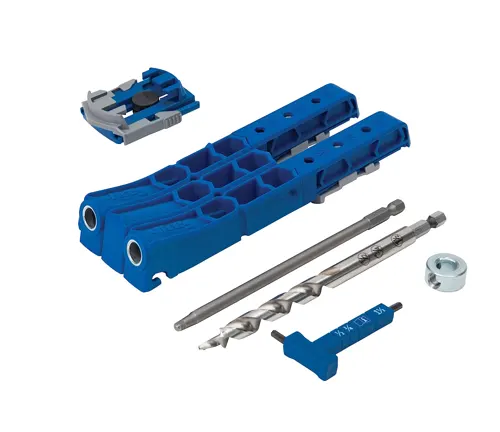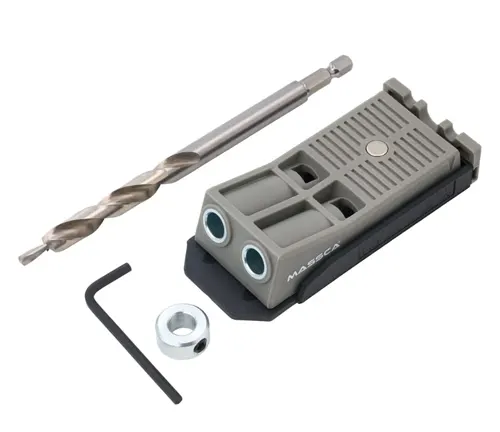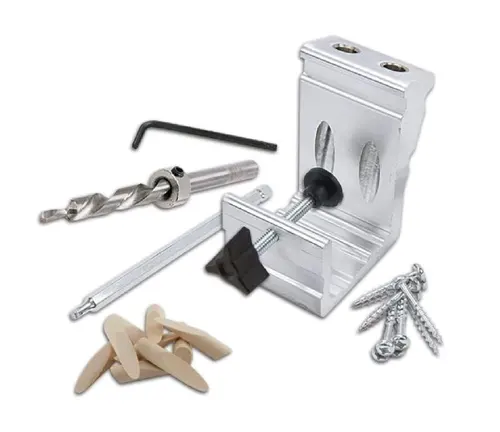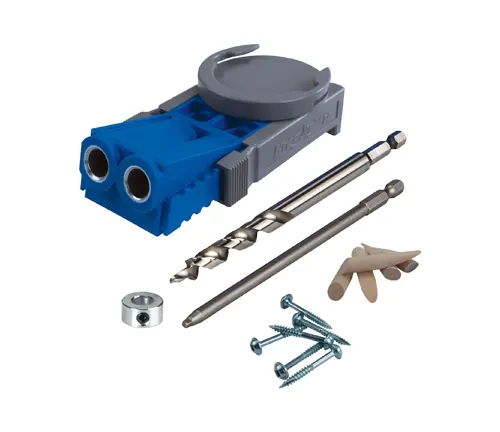The Best Pocket-Hole Jigs for Woodworking of 2024
- April 3, 2024
- 0 comment
The Best Pocket-Hole Jigs for Woodworking. These ingenious tools not only simplify the process of joining pieces of wood but also ensure strong, durable connections that stand the test of time. Whether you’re a seasoned woodworker or a DIY enthusiast, having the best pocket-hole jig in your toolkit can elevate your projects to new heights. In this guide, we explore the top picks for pocket-hole jigs, each carefully selected for its precision, ease of use, and versatility. Get ready to transform your woodworking tasks with efficiency and finesse.
Our Top Picks of Best Pocket-Hole Jigs for Woodworking
1. KREG kphj320 Pocket-hole Jig 320
Product Specs
- Material Capacity: ½” to 1½” (13mm – 38mm) thick
- Drill Guide Spacings: Two pre-set options (19mm and 38mm), unlimited when drill guides are separated
- Construction: Glass-filled nylon, hardened steel, thermoplastic elastomer
- Number of Drill Guides: 2 with twist-apart design
- Clamping Method: Works with Kreg Clamps and most other clamps (not included)
- Warranty: Lifetime warranty on Drill Guides
Pros
- Compact and portable (great for tight spaces)
- Easy to set up and use (good for beginners)
- Creates strong joints
- Durable construction with lifetime warranty on key parts
Cons
- Limited material thickness range (not ideal for very thick wood)
- Less versatile than some larger jigs (fewer drilling options)
The Kreg KPHJ320 stands out as a top-notch, versatile pocket-hole jig ideal for various DIY woodworking endeavors. It boasts dual drill guides, a detachable spacer, and customizable stops suitable for materials of ½, ¾, and 1½ inches in thickness. Included in the set are a dual-purpose hex key/material thickness gauge, a stepped drill bit with a depth stop that can be adjusted, along with a stop collar, a clamp adapter pad, and a square drive screwdriver bit. The jig, accompanying tools, and a set of 40 trial pocket-hole screws are neatly packed in a durable plastic carrying case for easy organization and transport.
2. Massca Twin Pocket-Hole Jig Set
Product Specs
- Bushings/Drill Guide Sizes: This will determine the size of the pocket holes you can create. A common size is a Kreg Jig standard (3/8″).
- Material Compatibility: Some jigs are designed for specific materials like wood or composite boards.
- Workpiece Thickness Capacity: This will tell you the range of wood thicknesses the jig can handle.
- Clamping Mechanism: Some jigs have built-in clamps while others require separate clamps.
- Dust Collection Port: This helps with dust management while drilling.
Pros
- The magnetic base and built-in gauges (workpiece thickness, drill depth) are designed for quick setup and simple operation, making it ideal for beginners.
- It can handle a range of wood thicknesses (usually ½” to 1½”).
- Often comes with a drill bit, stop collar, square driver, hex key, and sometimes even pocket hole screws, so you have everything you need to get started.
- Compared to some name brands, Massca tends to be a budget-friendly option.
Cons
- Massca may not be as established as some other pocket-hole jig brands, so there might be less user reviews and long-term durability information available.
- Being a budget option, it might be made with less robust materials compared to high-end jigs.
- There are some user reviews mentioning potential for slight inaccuracies in drilling, especially if the jig is not secured properly.
For those who might need a tool for just one or two projects, the affordably priced pocket-hole jig set by Massca presents an appealing choice for the occasional hobbyist. This cost-effective kit comes with a pair of guide holes and is equipped with essential accessories like a drill bit, hex key, and stop collar, offering nearly everything required for wood joining with pocket holes.
Designed for ease of use, this kit is compatible with wood thicknesses ranging from ½ inch to 1½ inches. It features an integrated material thickness stop and a gauge for setting drill depth. Additionally, a built-in magnet enhances convenience by swiftly securing the thickness stop plate, facilitating the use of steel clamps.
The straightforward, single-piece structure of the Massca Twin jig caught our attention for its practicality. The spacing of the drill guide holes at 1½ inches apart is ideal for creating double-pocket holes in the ends of 1×2 lumber pieces. Its compact size makes this tool particularly handy for smaller scale projects, such as assembling the corners of picture frames.
3. Kreg KPHJ920 Pocket-Hole Jig XL
Product Specs
- MaterialCompatibility:Primarily for wood thicknesses up to 3.5″ (89mm) such as 2x4s and 4x4s
- Drill Guide: Hardened steel, double guides with adjustable spacing
- Drill Bit: Included stepped drill bit for pocket holes (diameter not specified)
- Clamping: Clamp pad adapter compatible with Kreg clamps and most other brands (clamps sold separately)
- Other Features: GripMaxx non-slip base
Pros
- Strong Joints: Creates extra-large pocket holes for stronger joints in thick lumber (2x4s and 4x4s).
- Versatile: Adjustable drill guides allow for pocket hole placement customization.
- Easy to Use: Simple setup with clear material thickness settings.
- Durable: Impact-resistant construction and hardened steel drill guides.
- Stable: GripMaxx material prevents slipping during use.
- Clamping Options: Clamp pad adapter works with Kreg clamps and most other brands (clamps not included).
Cons
- Limited Material Thickness: Primarily for thick lumber, not ideal for thinner projects.
- Bulkier Design: May be less maneuverable compared to standard pocket hole jigs.
- Cost: More expensive than basic pocket hole jigs.
- Requires Specific Screws: Needs Kreg XL Pocket-Hole Screws (sold separately).
While many pocket-hole jigs cater to small to medium woodworking projects involving lumber thicknesses of ½ inch to 1½ inches, such as picture framing or cabinet making, the Kreg XL jig is designed for more robust tasks. It’s suitable for working with larger pieces of wood ranging from 1½ inches to 3½ inches thick, making it ideal for tasks involving 2×4 and 4×4 boards. The set is comprehensive, including two XL drill guides, an XL stepped drill bit with a ½-inch diameter featuring an easy-to-adjust depth stop collar, a hex key, an adjustable non-slip clamp pad, and a #3 XL square driver bit.
Constructed from durable polymer and featuring steel guide sleeves with a non-slip rubber base, this Kreg jig model ensures longevity and stability during use. The drill guides are equipped with detachable material thickness gauges and are held together by twist-and-slide locking tabs, providing flexibility for various project requirements. The ½-inch drill bit is specifically designed to accommodate Kreg’s #14 2 ½-inch XL pocket-hole screws, ensuring a snug fit without splitting the wood, a notable advantage over other jigs that typically use ⅜-inch drill bits suitable for smaller screws.
4. General Tools 850 E-Z Pro Deluxe Pocket-Hole Jig Kit
Product Specs
- Material: Heavy-duty aluminum jig body with hardened steel drill bushings
- Drill Bit: #32 – 3/8″ replaceable step drill bit
- Clamping: Built-in clamping system
- Joint Types: Flush, corner, and angle pocket hole joints
- Additional Components:
- 3/8 in. steel stop collar
- Hex wrench
- 6 in. square drive bit
- Pocket hole screws (quantity may vary)
- Wooden pocket hole plugs (quantity may vary)
- Carrying Case: Hard molded carrying case
Pros
- Strong joints, easy setup: Makes secure connections, user-friendly.
- Versatile: Creates flush, corner, and angled joints.
- Durable: Built with tough aluminum and steel for long life.
Cons
- Limited material thickness options: Might not work for very thin or thick wood.
- Clamping required: Needs separate clamps to secure workpiece.
The durability of metal significantly surpasses that of plastic, a fact that elevates the appeal of General Tools’ pocket jig. Crafted from a single block of cast aluminum, this heavy-duty pocket jig is priced affordably and is built to withstand numerous pocket drilling tasks.
General Tools has outfitted the 850 model with a user-friendly internal clamping mechanism to expedite project completion, as well as steel drill guide sleeves to enhance its longevity. The set is comprehensive, coming with a drill bit, a stop collar, and a hex wrench. It also includes an initial assortment of 50 square screws, available in either coarse or fine threads, 25 wooden pocket hole plugs, and a sturdy plastic case for transport. This pocket-hole jig kit is versatile, functioning seamlessly as both a mobile and a bench-mounted tool.
5. Massca M2 Pro Aluminum Pocket-Hole Jig System Bundle
Product Specs
- Material: Aluminum [1, 2] – This makes it sturdy and lightweight.
- Clamping System: Clamps included for securing wood while drilling [2].
- Adjustable Depth Stop: Allows for precise control over pocket hole depth [2].
- Dust Collection Port: Helps keep your workspace clean by collecting sawdust [2].
Pros
- Durable: Aluminum construction for long life.
- Easy to Use: Adjustable depth stop and dust collection for convenience.
- Precise: Clamping system ensures accurate pocket holes.
- Versatile: Useful for various woodworking projects.
Cons
- Price: Might be pricier than some plastic jigs.
- Limited Specs: Specific measurements and weight might be unavailable.
The Massca M2 stands out in our selection for its premium price point, which is more than twice that of its closest competitor, and our testing revealed the reasons behind its higher cost. The superior material quality was evident right from the start, with its cast-aluminum body, the smooth functionality of the adjustable steel drill guide, and the robust face clamp. Moreover, as we continued to use the tool, its well-considered design features and conveniences became increasingly apparent.
For benchtop mounting, the process involved securing the jig with four screws through the base plate’s designated holes. Alternatively, there’s the flexibility to attach it to a T-track system. The face clamp’s design allowed for effortless movement forwards and backwards, enabling quick securing and releasing of workpieces. Adjusting the clamp to accommodate different wood thicknesses was straightforward and once set, it remained firmly in place without any slipping, and disengaging it was virtually effortless.
6. MulWark MLK-53775 Premium Pocket-Hole Jig System Kit
Product Specs
- Material Compatibility: Wood boards from 1/2 inch to 1 1/2 inch thickness
- Jig Angle: 15 degrees (for creating pocket holes)
- Drill Bit: Step drill bit (creates pilot hole, clearance hole, and countersink hole in one pass)
- Driver Bit: Square driver bit (for driving pocket hole screws)
- Adjustment Tool: Hex wrench (for adjusting the jig)
- Pocket Hole Plugs: Wooden plugs (optional, for concealing pocket holes)
Pros
- Affordable
- Easy to use (great for beginners)
- Compact size
- Creates strong hidden joints
Cons
- Limited material thickness (1/2″ to 1.5″)
- Might not be as durable as high-end jigs
The MulWark pocket-hole jig offers a straightforward and efficient solution for hobbyists in need of a reliable tool for smaller to mid-sized woodworking projects, such as assembling picture frames or crafting furniture. The kit is well-equipped, featuring a dual-hole jig, square driver bits of 6 inches and 3 inches, a ⅜-inch stepped drill bit, a stop collar for depth limitation, a ⅛-inch hex wrench, an assortment of fifty screws in various sizes, and a comprehensive user guide.
Designed with user convenience in mind, this model boasts more than nine settings for jig positioning, nine settings for measuring thickness, and seven depth adjustments, catering to wood boards from ½-inch to 1 ½ inches in thickness. The incorporation of a magnet within the jig’s body further enhances usability by facilitating attachment to standard metal clamps. The kit also includes a variety of coarse square driver screws in five sizes and a collection of five plastic plugs. Additionally, a compact carrying case is provided, ensuring that all components remain organized and readily available for use.
7. Kreg R3 Pocket-Hole Jig System
Product Specs
- Material Thickness Capacity: 1/2″ to 1 1/2″ (12mm to 38mm) in 1/8″ (3mm) increments
- Drill Guide Size: Two 9mm diameter standard Kreg® pocket hole drill guides
- Drill Guide Spacing: 7/8″ center-to-center
- Body Material: Glass-filled nylon
- Clamping Method: Works with any standard bar clamp, C-clamp, or Kreg Face Clamp (for faster and more repeatable results)
Pros
- Portable & Easy to Use: Great for beginners and working on projects anywhere.
- Strong Joints: Creates invisible, hidden pocket hole joints for a clean look.
- Versatile: Works with various wood thicknesses (1/2″ to 1 1/2″).
Cons
- Limited Capacity: Not ideal for very thick materials.
- Manual Clamping: Requires a separate clamp (not included).
The R3 model is constructed from glass-filled nylon paired with hardened steel drill guide sleeves, ensuring exceptional longevity. It comes with an adaptor for the clamp pad, making it straightforward to fasten the jig directly to your workpiece using any standard bar clamp, C-clamp, or Kreg face clamp. The jig features slide-locking stops for material thickness on both sides, which can be adjusted to one of nine positions in ⅛-inch increments, ranging from ½ inch to 1½ inches, to suit the dimensions of your workpiece. Included in the set are a ⅜-inch stepped drill bit accompanied by a stop collar and hex key, a 6-inch square drive screwdriver bit, a selection of fifty pocket-hole screws, and five pocket-hole plugs, all organized within a durable carrying case.
While the Kreg R3 shares similar design features and proportions with other jigs like the Massca Twin, MulWark, and WorkPro models we evaluated, it emerged as our top recommendation for novices for several reasons. Despite being slightly pricier than its counterparts, the R3 distinguished itself through its quicker setup, more user-friendly adjustments, and its ability to create neater holes.
8. WorkPro W124696A Pocket-Hole Jig Kit
Product Specs
- Brand: WORKPRO
- Manufacturer Part Number: W124696A
- Weight: 2.07 lbs (assembled)
- Material Thickness Capacity: ½” to 1-½” (12mm to 38mm)
- Drill Bit: 3/8″ step drill bit
- Stop Collar: 3/8″ steel stop collar
- Drive Bit: 6″ square drive bit
- Hex Wrench: 1/8″ hex wrench
- Wood Plugs: 20 x 3/8″ plastic plugs
- Coarse Square Drive Screws: 120 pcs (various lengths from 1″ to 2-1/2″)
- Carrying Case: Included
Pros
- Easy to Use: Simple design, clear markings, and instructions make it beginner-friendly.
- Effective: Creates strong and stable pocket hole joints.
- Compact: Takes up minimal storage space.
Cons
- Less Precise: May not be as accurate as higher-end jigs, leading to potential tear-out and needing more sanding.
- Flimsy Case: Included case might not be the most durable for frequent transport.
- Limited Screw Options: Screws may not be ideal for all projects (softwood focus).
- Plastic Plugs: Not ideal for high-quality finishes (may not match well with wood).
The WorkPro pocket-hole jig kit is designed to handle wood pieces ranging from ½ inch to 1½ inches in thickness. It features a dual-hole design crafted from molded plastic with durable hardened steel drill guide sleeves. The jig also includes an adjustable stop for material thickness and a magnetic clamp pad integrated into the design. Accompanying the jig are a ⅜-inch stepped drill bit complete with an adjustable depth stop collar and hex key, a square drive screwdriver bit, a collection of 120 various pocket-hole screws, and 20 pocket-hole plugs.
A standout feature of this jig is its built-in stop for material thickness, which provides nine selectable positions at ⅛-inch intervals. This stop incorporates a gauge for the drill bit stop collar, which removes the necessity for manual measurement, with indicators available in both millimeters and inch fractions.
What to Consider When Choosing a Pocket-Hole Jig
- Material and Construction: The durability and longevity of a pocket-hole jig depend largely on its construction materials. Options range from hardened steel and aluminum to plastic. Metal jigs tend to offer greater durability and precision.
- Thickness Capacity: Different jigs are designed to handle various thicknesses of wood. Consider the range of material thicknesses you’ll be working with and ensure the jig can accommodate them.
- Adjustability and Settings: Look for a jig that offers adjustable settings for material thickness, drilling depth, and guide spacing. This flexibility allows you to work with a wide range of project sizes and specifications.
- Clamping Mechanism: A robust clamping system is crucial for securing the jig to your workpiece. Some jigs come with integrated clamps, while others require separate clamps. The ease and reliability of the clamping mechanism can significantly impact your workflow.
- Drill Guides: The quality and design of the drill guides influence the accuracy of your pocket holes. Hardened steel drill guides with a smooth interior surface ensure precise drilling and minimal bit wear.
- Portability: If you need to use the jig in various locations, consider its portability. Some jigs are compact and lightweight, making them easy to transport, while others are larger and better suited for stationary use in a workshop.
- Ease of Use: The user-friendliness of the jig can make a big difference, especially for beginners. Features like clear markings, easy-to-adjust settings, and straightforward operation can enhance your woodworking experience.
- Accessories and Extras: Some pocket-hole jigs come in kits that include additional accessories such as drill bits, drivers, screws, and plugs. These extras can offer added value and convenience, especially if you’re starting from scratch.
- Brand Reputation and Support: Choosing a jig from a reputable brand can ensure quality and reliability. Additionally, good customer support and availability of replacement parts can be beneficial in the long run.
- Price: Pocket-hole jigs come in a range of prices, from budget-friendly options to high-end models. Consider your specific needs and how often you’ll use the jig to determine a budget that makes sense for you.
Conclusion
In conclusion, the right pocket-hole jig is crucial for enhancing the quality and efficiency of woodworking projects. The best jig should be durable, adaptable, and easy to use, fitting various project sizes and material thicknesses. Whether for hobbyist DIY tasks or professional-grade work, choosing a jig that meets your specific requirements is key. With the wide range available, from budget-friendly to advanced models, finding the ideal jig can significantly improve your woodworking, making every joint stronger and every project more seamless.
FAQs
- What is a pocket-hole jig?
A pocket-hole jig is a specialized tool used in woodworking to drill angled holes into one piece of wood, allowing it to be attached to another piece with a screw, creating a strong, hidden joint. - Why use a pocket-hole jig in woodworking?
Pocket-hole jigs allow for quick, strong, and precise joints, making them ideal for a variety of woodworking projects, from furniture assembly to cabinetry. They offer a simple method for achieving professional-looking results. - How do I choose the best pocket-hole jig?
Consider factors like material durability, adjustability for different wood thicknesses, ease of use, the inclusion of necessary accessories, and the jig’s suitability for your specific project sizes and needs. - Can beginners use pocket-hole jigs?
Yes, pocket-hole jigs are beginner-friendly. Many models are designed with user-friendliness in mind, featuring clear instructions and simple adjustments. - Are there different types of pocket-hole jigs?
Yes, pocket-hole jigs range from simple, single-hole jigs suitable for occasional use, to complex systems with multiple guides and settings for professional-grade work. - What should I look for in a pocket-hole jig kit?
Look for a kit that includes essential accessories like drill bits, a driver bit, a clamp, depth stop collars, and a selection of screws and plugs for a comprehensive solution. - Can pocket-hole jigs be used with any type of wood?
Most pocket-hole jigs are versatile enough to be used with a wide range of wood types and thicknesses, but it’s essential to check the specific capabilities of the jig you’re considering. - How do I maintain my pocket-hole jig?
Regular cleaning to remove sawdust and debris, proper storage to avoid damage, and occasional lubrication of moving parts can help maintain your pocket-hole jig in good condition. - Where can I find the best pocket-hole jigs?
Pocket-hole jigs are available at most hardware stores, online retailers, and specialty woodworking shops, offering a range of options to suit various needs and budgets. - Do pocket-hole jigs come with a warranty?
Many manufacturers offer warranties on their pocket-hole jigs, providing added peace of mind. Check the product details or contact the manufacturer for warranty information.

Joel Cunningham
Forestry AuthorI'm Joel Cunningham, an expert in pruning and weed management with over a decade of experience. My skills are rooted in formal training and extensive practice, focusing on advanced pruning techniques and efficient weed control. I'm known for my quality work, precision, and deep understanding of plant health and soil dynamics. My contributions extend to educational initiatives where I share sustainable practices and advice, establishing myself as a reliable and authoritative figure in the gardening community.





















Leave your comment